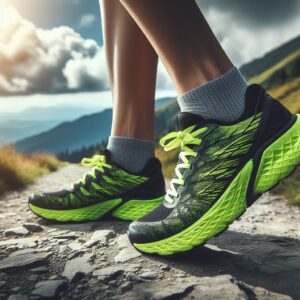Each time your foot hits the ground during a run, it experiences a process known as the gait cycle. This cycle consists of two main phases: the “stance” phase, when your foot is in contact with the ground, and the “swing” phase, when your foot is moving forward. The stance phase further breaks down into the moment of impact, midstance, and push-off.
During the stance phase, how your foot naturally rolls inward is called pronation, and it’s part of the body’s natural shock absorption mechanism. The degree of pronation varies among individuals. Overpronation occurs when the foot rolls inward too much, while underpronation (or supination) is when the foot doesn’t roll inward enough. A neutral pronation is somewhere in between, where the foot rolls inward at a moderate amount.
Running shoe design takes these variances in pronation into account by providing different levels of support and structure within the shoe
Motion control shoes are the most rigid and durable. They offer features such as reinforced heels and a straight last, which is the mold around which the shoe is built. They are designed for people who heavily overpronate, helping to stabilize the foot and prevent too much inward rolling.
Stability shoes are designed for runners who exhibit mild to moderate overpronation. Stability shoes include features such as dual-density foam, where a firmer foam is used on the inner side of the shoe to offer support without the rigidity of a motion control shoe.
Neutral shoes are more flexible and cushioned, made for runners who have a neutral gait or underpronate. They allow for the natural movement of the foot without extra support structures that might restrict the natural stride of these runners.
Shoes with a higher drop may offer more heel support, which can be beneficial for runners with certain types of foot mechanics or those who are more heel-striking runners. Shoes with a low or zero drop can promote a more natural running position, but may require a transition period and should be chosen carefully based on individual comfort and running style.
Modern technologies have introduced a variety of cushioning materials, such as memory foam, EVA, or gel that adapt to your foot’s contours, absorb impact, and provide a responsive feel to each step.
Assessing Your Unique Running Style and Needs
Identifying your running style starts with examining your running form. This can include your posture, where your foot lands with each stride, and how your weight transfers throughout your step.
A primary element to consider is your cadence or the number of steps you take per minute. A higher cadence with shorter strides minimizes the impact on your joints and can affect the type of shoe that will be most comfortable for you. A slower cadence with longer strides might require more cushioning to absorb the greater forces impacting your legs.
If you are training intensively and running high mileage each week, your feet will need resilient cushioning and support to withstand the repetitive stress. This means shoes with the right balance between protection and responsiveness.
Different terrains can impact your joints and muscles in varying ways, and there are shoes designed specifically for different surfaces. Road shoes are built to absorb the impact of hard surfaces and provide smooth transitions, while trail shoes offer better grip and stability on unpredictable terrain.
If you have a history of knee, hip, or back discomfort, it may be due to your running mechanics and the stress they place on your body. A shoe that corrects or reduces the inefficiencies in your stride could help alleviate these issues.
Heavier runners often benefit from shoes with additional cushioning to reduce impact forces, while lighter runners may prefer the natural feel of less cushioned shoes.
If you’ll be running in an area with a lot of rain or high humidity, look for shoes with quick-drying materials and adequate drainage. Cold-weather runners might lean toward options with waterproofing and increased coverage.
Checking the Fit
Due to the swelling that can occur during long runs, and the need for additional space to accommodate the natural expansion and movement of your feet, it is not uncommon to select running shoes that are a half to a full size larger than what you would wear casually.
 When trying on running shoes, pay attention to the shoe’s width. The goal is to find a shoe that snugly secures your foot without inducing constriction. As you lace up, the shoes should feel secure around the midfoot and heel without any slippage, yet leave enough room in the toe box to wiggle your toes freely. The width should allow the foot to rest flat and spread naturally with each step.
When trying on running shoes, pay attention to the shoe’s width. The goal is to find a shoe that snugly secures your foot without inducing constriction. As you lace up, the shoes should feel secure around the midfoot and heel without any slippage, yet leave enough room in the toe box to wiggle your toes freely. The width should allow the foot to rest flat and spread naturally with each step.
Shoe lasts come in various shapes and caters to different foot structures. Straight lasts offer more room and accommodate wider feet or those with flat arches, while curved lasts may suit feet with higher arches and a more pronounced midfoot.
A properly fitting heel counter should grip your heel comfortably, preventing vertical or horizontal movement that can lead to blisters or loss of stability.
The supporting structure under your arch should align with your foot’s natural arch. Having adequate support in this area is necessary for maintaining foot alignment and distributing pressure evenly across the foot rather than overloading specific areas.
The shoes should be able to be laced up firmly but without creating excessive pressure on the top of your foot. Some running shoes come with alternative lacing techniques or systems that can help customize the fit to your feet.
It’s advisable to try on shoes later in the day when your feet are at their largest. Wear the type of socks you’ll be running in, and if you use custom orthotics or insoles, bring them with you to ensure they work well with the shoes.
Make sure to walk and jog in the shoes within the store, paying attention to any immediate concerns such as pinching, rubbing, or discomfort—as these signs can be indicators of an unsuitable fit. New running shoes should not require a ‘break-in’ period. They should feel comfortable and supportive straight out of the box.
The Role of Durability and Breathability
A marathon shoe must be built with robust materials that can withstand constant pounding on various surfaces, from rough asphalt to uneven trails. Features that contribute to a shoe’s durability include high-abrasion rubber outsoles, which provide resistance against surface wear. Manufacturers reinforce the areas that tend to make the most contact with the ground, like the heel and toe, to ensure even wear and longer-lasting performance.
Over time and with consistent use, the midsole can compress and lose its supportive and cushioning properties. High-quality foam materials or alternative cushioning technologies are developed to maintain integrity over time, ensuring the shoe remains supportive and stable throughout its life cycle.
An aspect related to durability is how well the shoes hold up structurally over time. The uppers should be designed to retain their shape and provide continuous support, using materials like reinforced mesh, synthetic overlays, and sturdy stitching to prevent tears or distortions that could alter the fit.
During long runs, feet can generate a considerable amount of heat and moisture. Well-ventilated running shoes become important for wicking away sweat, keeping the feet dry, and reducing the risk of blisters or the growth of bacteria that can cause foot odor.
Mesh panels, made of synthetic woven fabrics, offer excellent airflow to cool the feet. These breathable materials contribute to the shoe’s ability to manage internal moisture, pulling it away from the foot and allowing it to evaporate through the outer layers. Some running shoes incorporate moisture-wicking linings or antimicrobial footbeds to further enhance the shoe’s internal climate control.
In warmer environments or for runners whose feet sweat heavily, highly breathable shoes are important. In cooler or wetter conditions, one might look for shoes that offer a balance between air circulation and protection against the elements.
Breaking in Your Running Shoes and Understanding Their Lifecycle
When breaking in new running shoes, start by wearing them for short periods during daily activities. This allows your feet to adapt to the shoes and the shoes to conform slightly to the shape of your feet. As this process continues, you can take them on a series of shorter runs, incrementally increasing distance and intensity. This will enable you to notice any areas of discomfort that might not be apparent during a simple walk. It will give the shoes time to flex and the cushioning systems to settle into an effective rhythm with your running style.
The commonly accepted standard is that most running shoes should be replaced every 300 to 500 miles. This range can fluctuate depending on the runner’s weight, the shoe’s construction, the running style, and the terrain tackled. Runners should pay close attention to signs of wear in their shoes, such as unevenness in the soles, noticeable creases in the midsole foam indicating compression, or a general feeling of reduced support and cushioning.
Monitoring these details and keeping track of mileage can help you make an informed decision about when to retire a pair of running shoes. It’s beneficial to rotate between two pairs of shoes to extend their respective lifespans and provide a safeguard in case one pair begins to wear out close to an important race or the peak of your training.
